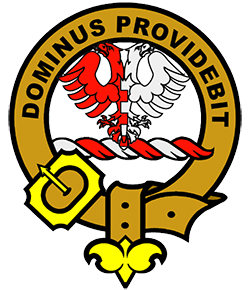Boyle Clan
Boyle Crest: A two headed eagle displayed, parted per pale embattled Gules and Argent
Boyle Clan Motto: Dominus Providebit (The Lord will provide).
Boyle Clan History:
The de Boyvilles, a family originally from Beauville near Caen in Normandy, arrived in England after William the Conqueror's invasion of 1066, and acquired lands in Wales where they became the ancestors of the earls of Cork and Shannon.
The Boyles were cousins of Hugo de Morville, who in 1124 was invited to accompany David I when he returned to Scotland from exile England. Hugo was appointed Hereditary Great Constable of Scotland, and among other possessions, was granted the lands of Cunningham and Largs. Around 1140, he settled the portion of the estate at Kelvin on the de Boyville family.
In 1291, Henry de Boyville succeeded Sir William Boyville as Keeper of the castles of Dumfries and Galloway and in 1296, Richard and Robert de Boyville were signatories of the Ragman Roll, the submission of the Scots barons to Edward I of England. The name subsequently became widespread throughout Ayrshire and Wigtownshire but by the fourteenth century the pronunciation had dropped to one syllable.
In 1488, John Boyle was killed at the Battle of Sauchieburn, fighting in support of James III of Scotland. The family estates were forfeited but later restored to his son, also called John, by James IV. The Boyles were loyal supporters of Mary, Queen of Scots, and thereafter Charles I, which did them no favours.
However, in 1681, John Boyle of Kelburn was elected a Commissioner to the Scottish Parliament and became Lord Boyle of Kelburn in 1699. In 1703, the earldom of Glasgow was created for his eldest son David in recognition of his legal work in drawing up the Act of Union which in 1707 united the parliaments of England and Scotland.
The 1st Earl of Glasgow was a staunch supporter of the Hanovarian monarchy and during the Jacobite Rising of 1715, rallied and financed troops at his own expense.
In succeeding generations, the Boyle earls of Glasgow comprised distinguished soldiers and sailors, fighting at Fontenoy in 1745, at Lauffeldt in 1747, and in a naval battle off Gibraltar in 1807.
The seventh Earl was Governor of New Zealand from 1891-1897.
Places of Interest:
Crawford Priory, nr. Cupar, Fife. Gothic mansion house constructed in the early 1800s, now ruined. Passed to Lady Gertrude Boyle, daughter of the 6th Earl of Glasgow, in the 1880s. Fairlie Castle, Fairlie, nr.
Largs, Ayrshire. 15th century tower house bought by the Boyles of Kelburn in 1656. Kelburn Castle, Fairlie, nr. Largs, Ayrshire. Held by the Boyles from the twelfth or thirteenth centuries, and still held by the Boyle
Earls of Glasgow, making it one of the oldest properties in Scotland to remain continually inhabited by the same family. The surrounding Country Centre is a popular visitor attraction. Tours of the castle, the ancient
ancestral home of the Boyle family, are available at certain times of the year. Kilbirnie Place, Kilbirnie, Ayrshire. Ruined medieval tower house situated high above a ravine. Passed from the Lindsay Earls of Crawford
to George Boyle, 4th Earl of Glasgow, in 1833. Rowallan Castle, Kilmaurs, nr. Kilmarnock. 16th century castle owned by David Boyle, 1st Earl of Glasgow, in the early 1700s. Now a luxury wedding venue with a golf course
in the grounds.
Surname distribution in Scotland: The Boyle surname occurs most often in Glasgow, Dunbartonshire, Renfrewshire and Lanarkshire.
Purchase a Clan Boyle certificate.

